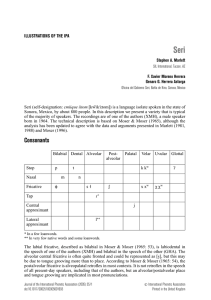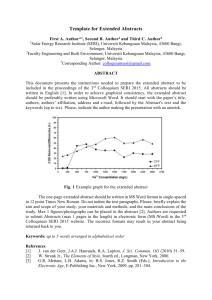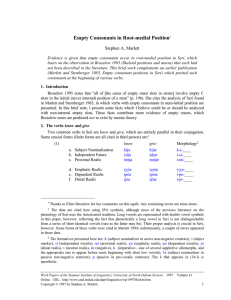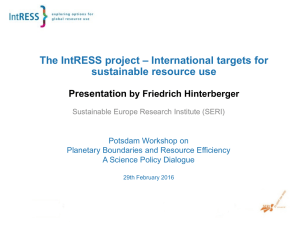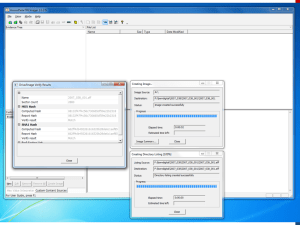The minimal word in Seri Stephen A. Marlett
advertisement
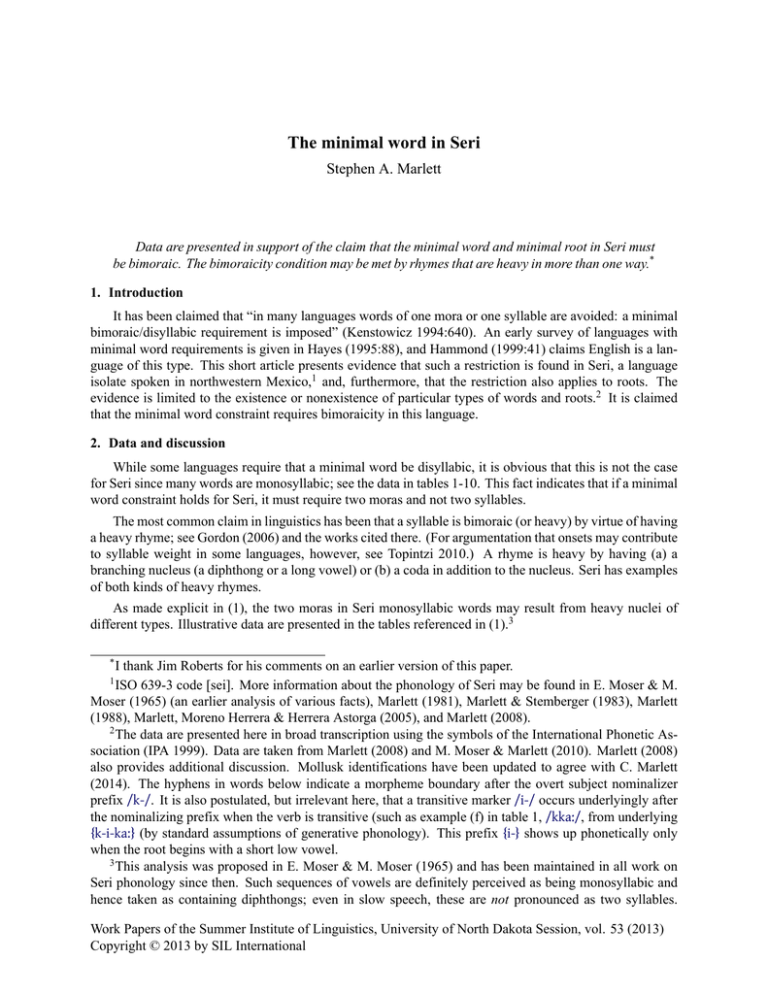
The minimal word in Seri
Stephen A. Marlett
Data are presented in support of the claim that the minimal word and minimal root in Seri must
be bimoraic. The bimoraicity condition may be met by rhymes that are heavy in more than one way.*
1. Introduction
It has been claimed that “in many languages words of one mora or one syllable are avoided: a minimal
bimoraic/disyllabic requirement is imposed” (Kenstowicz 1994:640). An early survey of languages with
minimal word requirements is given in Hayes (1995:88), and Hammond (1999:41) claims English is a language of this type. This short article presents evidence that such a restriction is found in Seri, a language
isolate spoken in northwestern Mexico,1 and, furthermore, that the restriction also applies to roots. The
evidence is limited to the existence or nonexistence of particular types of words and roots.2 It is claimed
that the minimal word constraint requires bimoraicity in this language.
2. Data and discussion
While some languages require that a minimal word be disyllabic, it is obvious that this is not the case
for Seri since many words are monosyllabic; see the data in tables 1-10. This fact indicates that if a minimal
word constraint holds for Seri, it must require two moras and not two syllables.
The most common claim in linguistics has been that a syllable is bimoraic (or heavy) by virtue of having
a heavy rhyme; see Gordon (2006) and the works cited there. (For argumentation that onsets may contribute
to syllable weight in some languages, however, see Topintzi 2010.) A rhyme is heavy by having (a) a
branching nucleus (a diphthong or a long vowel) or (b) a coda in addition to the nucleus. Seri has examples
of both kinds of heavy rhymes.
As made explicit in (1), the two moras in Seri monosyllabic words may result from heavy nuclei of
different types. Illustrative data are presented in the tables referenced in (1).3
*
I thank Jim Roberts for his comments on an earlier version of this paper.
ISO 639-3 code [sei]. More information about the phonology of Seri may be found in E. Moser & M.
Moser (1965) (an earlier analysis of various facts), Marlett (1981), Marlett & Stemberger (1983), Marlett
(1988), Marlett, Moreno Herrera & Herrera Astorga (2005), and Marlett (2008).
2
The data are presented here in broad transcription using the symbols of the International Phonetic Association (IPA 1999). Data are taken from Marlett (2008) and M. Moser & Marlett (2010). Marlett (2008)
also provides additional discussion. Mollusk identifications have been updated to agree with C. Marlett
(2014). The hyphens in words below indicate a morpheme boundary after the overt subject nominalizer
prefix /k-/. It is also postulated, but irrelevant here, that a transitive marker /i-/ occurs underlyingly after
the nominalizing prefix when the verb is transitive (such as example (f) in table 1, /kka:/, from underlying
{k-i-kaː} (by standard assumptions of generative phonology). This prefix {i-} shows up phonetically only
when the root begins with a short low vowel.
3
This analysis was proposed in E. Moser & M. Moser (1965) and has been maintained in all work on
Seri phonology since then. Such sequences of vowels are definitely perceived as being monosyllabic and
hence taken as containing diphthongs; even in slow speech, these are not pronounced as two syllables.
1
Work Papers of the Summer Institute of Linguistics, University of North Dakota Session, vol. 53 (2013)
Copyright © 2013 by SIL International
Marlett: The minimal word in Seri
(1)
2
Types of monosyllabic words with heavy nuclei and no coda
a. Long vowel; see table 1.
b. Two short vowels; see table 2.
c. Long vowel followed by a short vowel; see table 3.
d. Short vowel followed by a long vowel; see table 4.
a. ˈʔaː
there (adverb)
b. ˈʔɛː
antelope jackrabbit (Lepus alleni)
c. ˈkɛː
red-breasted merganser (Mergus serrator)
who says
d. ˈk-ɛː
e. ˈk-iː
who hears it
f. ˈk-kaː
who looks for it
g. ˈkoː
shovelnose guitarfish (Rhinobatos productus)
who tastes it
h. ˈk-piː
i. ˈtɛː
wrinkled spineflower (Chorizanthe corrugata)
j. ˈχaː
soon
k. ˈχxiː
bottle gourd (Lagenaria siceraria)
Table 1 Monosyllabic words with long vowels and no coda
a. ˈʔai
head louse (unpossessed)
b. ˈʔai
air, wind
c. ˈkoi
still (adverb)
Table 2 Monosyllabic words with a vowel cluster and no coda
a. ˈk-aːi
who makes it
b. ˈk-aːo who passes by it
c. ˈk-oːi
who goes with the intention of acquiring it
d. ˈjaːo
its path (a form related to /kaːo/ in (b))
Table 3 Monosyllabic words with a long vowel followed by a short vowel
Morpheme-internally, diphthongs occur only in the stressed syllable of the word; Syllables without onsets
only occur word-initially. Other evidence supports this analysis as well. Seri would have “yes” for the
first five parameters presented in Blevins (1995:218-219), assuming that word-initial onsetless syllables are
permitted by a positive specification for the Obligatory Onset parameter. What is important to note here
is that these parameters are not complete; Blevins points out (1995:239, note 35) that “for languages with
complex nuclei, a further specification of one (unmarked) or two (marked) additional elements is necessary”
(emhasis added — SM). This additional markedness in complex nuclei is clearly evident in the Seri data.
Marlett: The minimal word in Seri
3
a. ˈk-aiː
who is mature
b. ˈk-aiː
who wakes up part way
c. ˈk-oiː
who are standing
d. ˈtoiː
toward somewhere else (adverb)
Table 4 Monosyllabic words with a short vowel followed by a long vowel
As shown in (2), Seri monosyllabic words also may have two moras by having a coda. The types of
words mentioned in (2c-e) are doubly heavy, but this seems to have no significance; they are included here
simply for the sake of completeness.4
(2)
Types of monosyllabic words with heavy rhymes
a. Short vowel in the nucleus and a simple coda; see table 5.
b. Short vowel in the nucleus and a complex coda; see table 6.
c. Long vowel in the nucleus and a simple coda; see table 7.
d. Long vowel in the nucleus and a complex coda; see table 8.
e. Complex nucleus and a simple coda; see table 9.
f. Complex nucleus and a complex coda; see table 10.
a. ˈak
canvasback (duck) (Aythya valisineria)
b. ˈʔap mule deer (Odocoileus hemionus)
c. ˈʔaχ water
d. ˈkam a bark boring beetle
e. ˈkap palo blanco (Acacia willardiana)
f. ˈk-is what is raw
g. ˈkos a plant (Maytenus phyllanthoides)
h. ˈnas a small milkweed vine (Matelea pringlei)
i. ˈsaʔ
great horned owl (Bubo virginiana)
j. ˈstak coral
k. ˈtom money
Table 5 Monosyllabic words with a short vowel and a simple coda
4
It is interesting to note that final consonants are considered extrametrical for the purposes of stress
assignment in Seri (Marlett 2008). Thus there is a difference in the behavior of codas in the phonology of
the language.
Marlett: The minimal word in Seri
a. ˈʔant
land, earth, year
b. ˈʔast
stone, rock, mountain
c. ˈʔaχɬ
multicolored clam (Leukoma grata)
d. ˈiskt
his/her/its lungs
e. ˈk-aptx
what is wide
f. ˈkops
lightning bug (Lampyridae)
g. ˈkoʃt
cricket (Gryllidae)
h. ˈkotχ
brittle bush (Encelia farinosa)
i. ˈptkamn Cortez spiny lobster (Panulirus inflatus)
a seaweed (Colpomenia tuberculata)
j. ˈχpɛːtk
Table 6 Monosyllabic words with a short vowel and a complex coda
a. ˈʔaːn
smooth Pacific Venus clam (Chionista fluctifraga)
b. ˈʔaːp
wild tepary (plant) (Phaseolus acutifolius)
c. ˈɸɛːɬ
mallard (Anas platyrhynchos)
d. ˈkiːt
little heart shell (Carditamera affinis)
e. ˈkoːɬ
net bag
f. ˈk-oːm who is lying down
g. ˈk-oːs
who sings
h. ˈpɛːn
carrying pole, yoke
i. ˈʃiːk
bird (general term)
j. ˈχɛːn
raccoon (Procyon lotor)
Table 7 Monosyllabic words with a long vowel and a simple coda
a. ˈkaːmxʷ western screech owl (Megascops kennicottii)
b. ˈkaːnx
Gulf grouper (Mycteroperca jordani)
c. ˈk-aːpɬ
what is cold
d. ˈkaːtk
grasshopper
e. ˈk-oːkp what grows (like fruit)
f. ˈk-oːkx
what are two
g. ˈʃɛːmx
smoothhound shark (Mustelus sp.)
h. ˈχaːsx
cardon (cactus) (Pachycereus pringlei)
i. ˈχɛːskɬ
desert lavender (Hyptis albida)
j. ˈχtoːʃp
desert ground-cherry (Physalis crassifolia)
Table 8 Monosyllabic words with a long vowel and a complex coda
4
Marlett: The minimal word in Seri
5
a. k-aːiɬ
what is spacious
b. k-aːix
(the verb in the idiom for dizzy)
what is grooved
c. k-aːoɬ
d. k-aːom who asks for a gift from him/her
e. k-oaːn what is murky
f. koiːʃ
a category of non-poisonous spider
g. k-oiːx
what is tubular
h. k-oːit
who dances
i. paːix
narrowleaf willow (Salix exigua)
long sand dune
j. jaiːx
Table 9 Monosyllabic words with a complex nucleus and a simple coda
a. k-aːisχ
who cleans it
b. k-oaːɸp who jumps upwards
c. koaːɸt
whirlwind over land
d. koɛːpt
Gambel's quail (Callipepla gambelii)
e. k-oːipx what is oval
Table 10 Monosyllabic words with a complex nucleus and a complex coda
We also note that there are virtually no nouns, verbs or adjectives without two moras.5 See (3) for a
short list of “words” that represent a large set of unattested items whose absence in the language requires
explanation.
(3)
Unattested major class words: ˈpa, ˈto, ˈki, ˈsɛ, ˈχa, ˈsta, ˈk-o, ˈk-sa
Kenstowicz points out that “systems that impose minimal length restrictions typically allow deviations
in the nonlexical vocabulary” (1994:640); see also the discussion in Hayes (1995:88). In Seri there are nonlexical words that do not have two moras, as shown in table 11. All of the items in table 11 are written as
orthographic words in the community-based writing system although most are clitics.
The passive stem of √iː ‘hear’, which has a prefix p- that conditions an ablaut process, has a short vowel
for some speakers, as in /ˈtpɛ/ (‘it was heard ...’).
5
Marlett: The minimal word in Seri
a.
b.
c.
d.
e.
f.
g.
h.
i.
j.
k.
6
ʔa, ka, pi
Auxiliary words (enclitics)
ʔa, ʔi, ʔ, aʔ Focus words (enclitics)
ˈʔɛ
I, we (independent pronoun)6
i
Certainty (enclitic)
ma, ta
Different Subject markers (enclitics)
ˈmɛ
you (sg., pl.) (independent pronoun)
ʃo, ʃ
Singular indefinite article/pronoun7
ˈʃo
how?
χ
Unspecified Time (enclitic)
χo
Emphatic (enclitic)
ˈχo
but
Table 11 Non-lexical words that do not have heavy rhymes
McCarthy & Prince (1995:323) point out that there is “one important language-specific aspect” to
prosodic word minimality, and that is “the level at which the minimality requirement is imposed.” In the
case of Seri, it appears to be true that roots and not just words are subject to the minimality requirement.
See the examples in (4) for another short list of “words” that represent a large set of unattested items whose
absence in the language requires explanation,8 although there may be one or two exceptional verbs (not
discussed here).9
(4)
Unattested: ˈk-a, ˈk-i, ˈk-o, ˈk-ɛ, ˈk-ta, ˈk-ti, ˈk-to, ˈk-tɛ, ˈt-o-tim, i-ˈt-e-tim, i-t-ˈsa, i-jo-ˈsa-tox
3. Conclusion
The data presented in this article support the claim that prosodic words and even roots in Seri must be
bimoraic. This statement could be refined even more if prosodic structure is directly related to foot structure
(see McCarthy & Prince 1995:321, where it is claimed that a prosodic word must consist of a foot). If this
were true, and given that Seri stress is quantity-sensitive (Marlett 2008), one could deduce that the minimal
word in Seri will allow heavy monosyllables and disallow light monosyllables. Since Garrett (1999) argues
that this direct relationship between foot structure and possible word cannot be maintained when a large
sampling of languages is considered, a simple constraint on word (and root) minimality is adopted here.
6
This word is distinguished orthographically from the word (b) in 1, but they are very similar phonetically. I also point out that while this pronoun and the second person pronoun below in this same table have
traditionally been ambiguous for number, innovative plural forms (ˈʔɛ-tax and ˈmɛ-tax, respectively) have
been documented in Larios Santacruz (2009).
7
Preconsonantal and prevocalic allomorphs, respectively. The article, which is phrase final, “wrongway” cliticizes to the word that follows.
8
The (unattested) roots have been inflected here with common verb prefixes (/i-/, /t-/, /jo-/, /k-/) and
suffixes (/-tim/, /-tox/). The cluster /kt/ is one of many possible complex onsets in Seri. See Marlett
(1988).
9
The root glossed ‘move’ that is found in the verb /ˈmo-k-a/ ‘who comes’ (towardSUBJECT.NOMINALIZER-move) is ostensibly monomoraic, but it only occurs in conjunction with a
directional prefix; see also /(i)nˈti-k-a/ ‘who goes’ (away-SUBJECT.NOMINALIZER-move). This root is
also unusual in that it requires that the stress be cast on a preceding syllable unlike the vast majority of
roots in the language (on which stress must fall). The /i/ after the prefix {nt} in the direction ‘away’ form
in /(i)nˈti-k-a/ ‘who goes’ is epenthetic and present only to receive the stress if there is no other vowel
available.
Marlett: The minimal word in Seri
7
References
Blevins, Juliette. 1995. “The syllable in phonological theory.” In John Goldsmith, ed. The handbook of
phonological theory, 1st Edition. 206-244. Oxford: Blackwell.
Garrett, Edward. 1999. “Minimal words aren't minimal feet.” UCLA Working Papers in Linguistics 1:68-105.
Gordon, Matthew. 2006. Syllable weight: Phonetics, phonology, and typology. New York: Routledge.
Hammond, Michael. 1999. The phonology of English: A prosodic optimality-theoretic approach. Oxford: Oxford
University Press.
Hayes, Bruce. 1995. Metrical stress theory. Chicago: University of Chicago Press.
IPA (International Phonetic Association). 1999. Handbook of the International Phonetic Association. Cambridge:
Cambridge University Press.
Kenstowicz, Michael. 1994. Phonology in generative grammar. Oxford: Blackwell.
Larios Santacruz, Maria Alfonsa. 2009. Sistema de alineamiento en construcciones bitransitivas de la lengua de los
Comcáac de Punta Chueca, Sonora. M.A. thesis. Hermosillo. University of Sonora.
Marlett, Cathy M. 2014. Shells on a desert shore: Mollusks in the Seri world. Tucson: University of Arizona Press.
Marlett, Stephen A. 1981. The structure of Seri. Ph.D. dissertation. La Jolla. University of California at San Diego.
Marlett, Stephen A. 1988. “The syllable structure of Seri.” International Journal of American Linguistics 54:245-278.
Marlett, Stephen A. 2008. “Stress, extrametricality and the minimal word in Seri.” Linguistic Discovery 6.1:1-14.
http://journals.dartmouth.edu/cgi-bin/WebObjects/Journals.woa/1/xmlpage/1/article/321
Marlett, Stephen A.; F. Xavier Moreno Herrera; & Genaro G. Herrera Astorga. 2005. “Seri.” Journal of the
International Phonetic Association 35:117-121.
Marlett, Stephen A. & Joseph P. Stemberger. 1983. “Empty consonants in Seri.” Linguistic Inquiry 14:617-639.
McCarthy, John J. & Alan S. Prince. 1995. “Prosodic morphology.” In John Goldsmith, ed. The handbook of
phonological theory, 1st Edition. 318-366. Oxford: Blackwell.
Moser, Edward W. & Mary B. Moser. 1965. “Consonant-vowel balance in Seri (Hokan) syllables.” Linguistics: An
International Review 16:50-67.
Moser, Mary B. & Stephen A. Marlett, compilers. 2010. Comcaac quih yaza quih hant ihiip hac: Diccionario
seri-español-inglés. 2nd Edition. Mexico City & Hermosillo: Plaza y Valdés Editores & Universidad de Sonora.
Topintzi, Nina. 2010. Onsets: Suprasegmental and prosodic behaviour. Cambridge: Cambridge University Press.
Steve Marlett
16131 N Vernon
Tucson, AZ 85739
steve_marlett@sil.org

